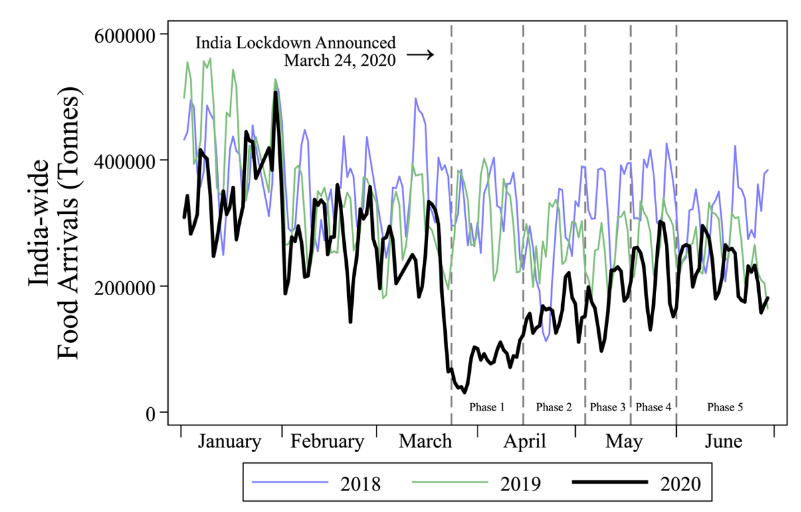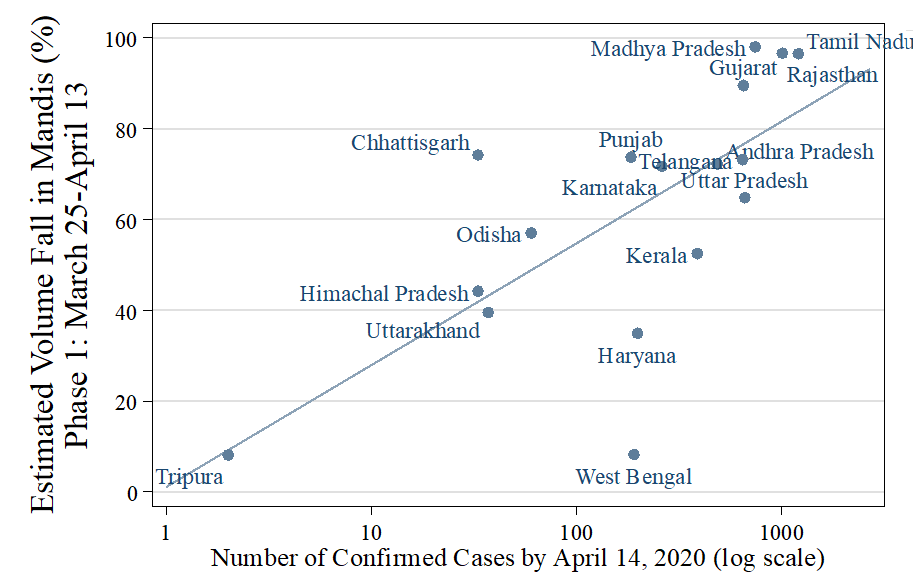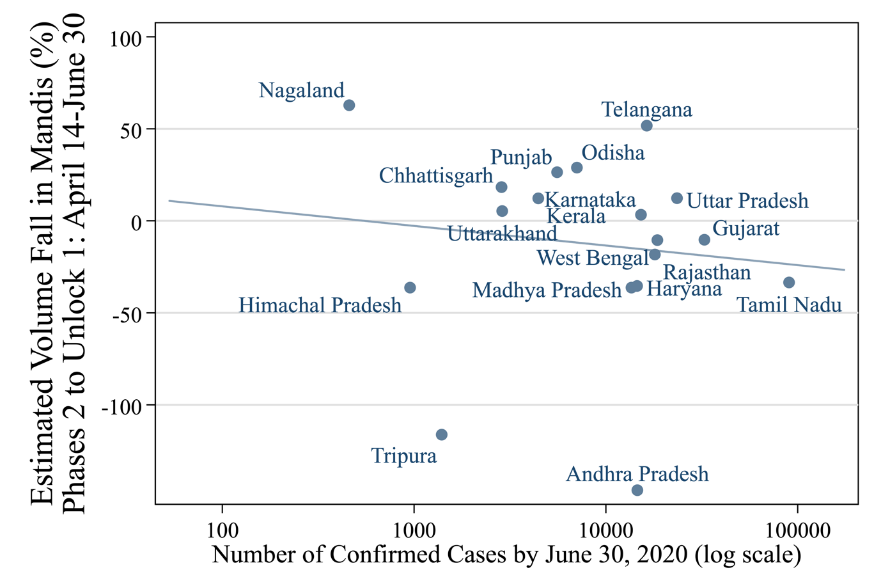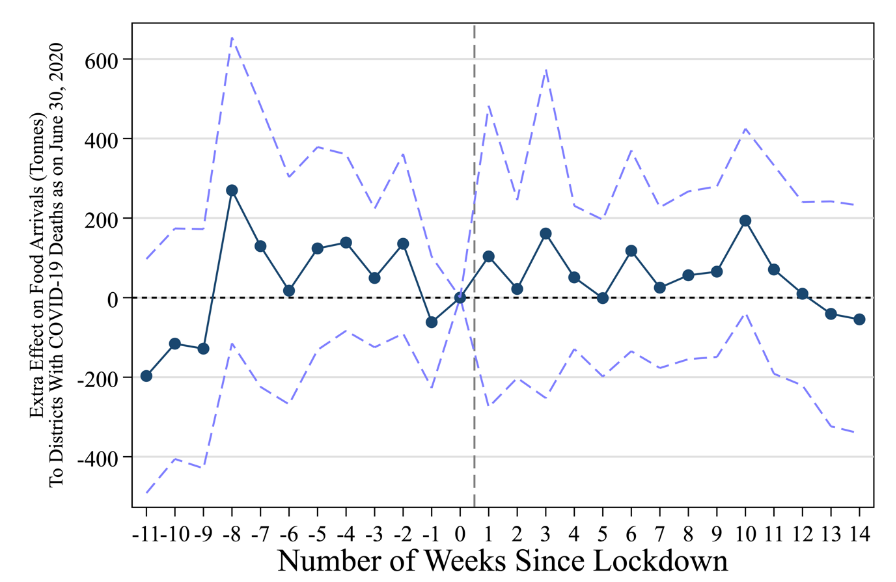We quantify the extent of supply chain disruptions in food markets during the nation-wide lockdown in India in response to COVID-19 by looking at volumes and prices in wholesale food markets across the country during different phases of lockdown. Food arrivals fell by around 60% following the announcement of lockdown, but volumes recovered to near normal levels within two months. The initial fall in food arrivals was highly correlated with the prevalence of COVID-19 at the state-level, but within each state, COVID-19-hit districts were no harder hit than others. This suggests that state-level policies drove supply chain responses rather than localised fears of contracting the virus. Our findings together underscore the need for state government policies to minimise supply chain interruptions during such lockdowns.
The Indian government announced a strict national lockdown to fight COVID-19 on March 24, 2020. One particular policy concern in this context has been whether food supply chains can remain functional in the face of a national lockdown, or whether food shortages would exacerbate the welfare costs of the lockdown. In this project, we look at the evolution of India’s food supply chain during the first four months of India’s national lockdown. India’s initial lockdown lasted for 21 days, with three subsequent extensions of 14 days each, with each phase accompanied by relaxations in lockdown rules. We document the magnitude of the initial impact on food supply and wholesale prices and the extent of the recovery. Our main data source is publicly available daily data on wholesale volumes and prices for 266 commodities traded at 1804 agricultural markets in 24 states of India. These commodities are primarily food items which form a significant proportion of the consumption of poor.
We report five main facts. First, food arrivals in wholesale markets dropped by 64% on average in the month following the lockdown (Figure 1) while wholesale prices rose by about 10%. The fall in volume comprised both extensive and intensive margin changes as India witnessed the shutting down of a number of agricultural markets following the lockdown as well as a fall in volume of food arrivals in the markets that remained functioning. Second, after the first phase of the lockdown ended, volumes steadily recovered, reaching similar levels to those in 2019, while prices gradually returned to a declining trend.
Figure 1: Food arrivals across India
The lockdown caused volumes across Indian markets to plummet

Note: y-axis is a three-day moving average of arrival volumes, excluding wheat. Excludes Republic Day, Holi, Sundays. Sample comprises mandis that reported data at least once in March 2020. Source: agmarknet.gov.in.
We then exploit spatial variation in the evolution of food supply to understand the relationship between coronavirus prevalence and food supply. As our third fact, we show that the initial state-level food supply shock was highly correlated with the state-level incidence of COVID-19 – states with more COVID-19 cases suffered much larger drops to food arrivals after the lockdown relative to previous years (Figure 2). As our fourth fact, we show that in the recovery phase, the correlation between state-level COVID-19 incidence and the food supply shock has dissipated, suggesting that by the end of June, supply chain functioning was uncorrelated with COVID-19 prevalence (Figure 3).
Figure 2: Estimated volume fall in mandis and number of confirmed coronavirus cases, phase 1
States with more coronavirus cases had bigger supply chain disruptions during the first phase

Note: Correlation between Number of Confirmed Cases by April 14, 2020 and Estimated Volume Fall in Mandis (%) is .71. The lockdown non-wheat volume drop is estimated from state-by-state difference-in-differences regressions, using data from March to June 2019 and 2020. Source of coronavirus cases: api.covid19india.org.
Figure 3: Estimated volume fall in mandis and number of confirmed coronavirus cases, phase 2
Volume shocks were not correlated with coronavirus cases during the second phase

Note: The lockdown non-wheat volume drop is estimated from state-by-state difference-in-differences regressions, using data from March to June 2019 and 2020. Source of coronavirus cases: api.covid19india.org.
Fifth and finally, we exploit the intra-state variation in food supply and intensity of the virus spread to look at whether the changes in food supply reflect state-level policies or the responses of market participants to the extent of coronavirus locally. We estimate the extra effect of COVID-19 intensity at district level controlling for state level policies through state fixed effects. We show that once we control for state-level policies, food arrivals at district-level are not significantly different in high COVID-19 districts as compared with the rest (Figure 4).
Figure 4: Extra effects on food arrivals and district-level incidence of COVID-19
The lockdown effects in districts with high rates of COVID-19 and low rates of COVID-19 were similar within the same state

Note: The figure denotes coefficient estimates from a triple difference-in-differences regression along with 95% confidence intervals. Standard errors are clustered at the district level.
It is striking that, within a state, volumes have not been differentially impacted in districts that faced deaths from COVID-19 versus those with zero deaths. Coupled with our other findings, it appears that supply disruptions are more likely driven by state and central government lockdown policies, and less by localized exposure to the virus and the overall fear of the disease. If state and central policies continue to relax, this logic suggests that supply chains will remain largely unimpacted, even as cases continue to rise in India.
Authors' Note: The authors would like to acknowledge field assistance from Simranjeet Dhir and Toshan Majumdar, and research assistance from Pulkit Aggarwal. The analysis and opinions expressed in this piece are solely those of the authors.
This note is based on research conducted as a part of PEDL project ERG 6661.





